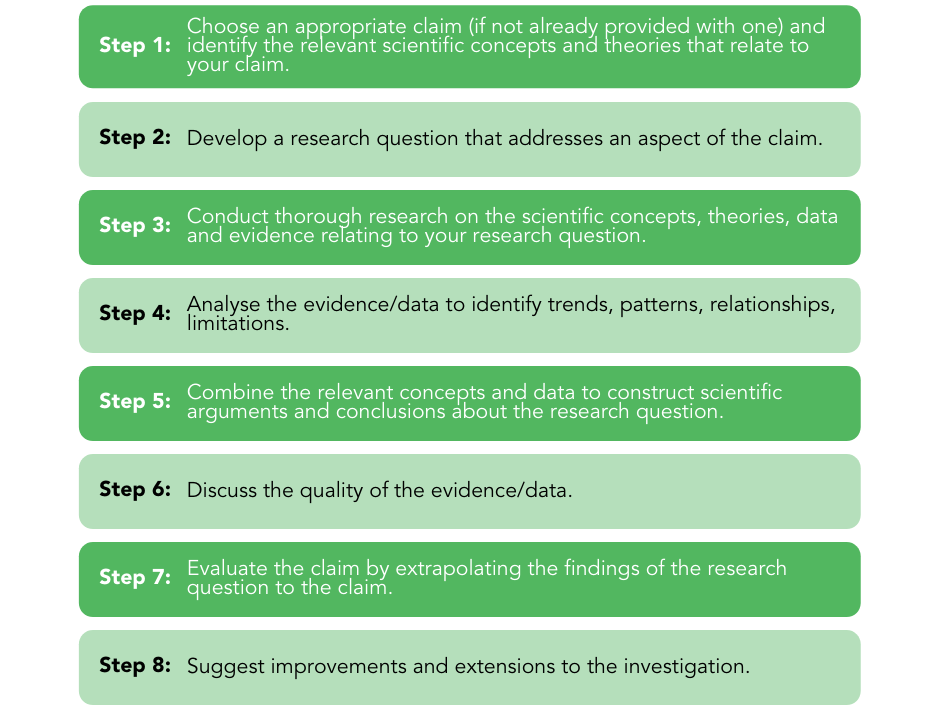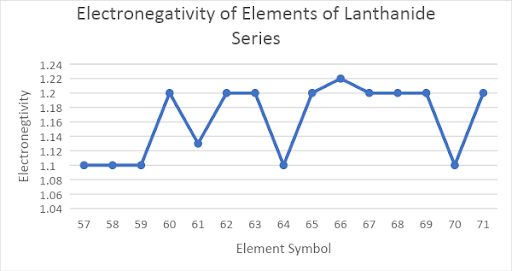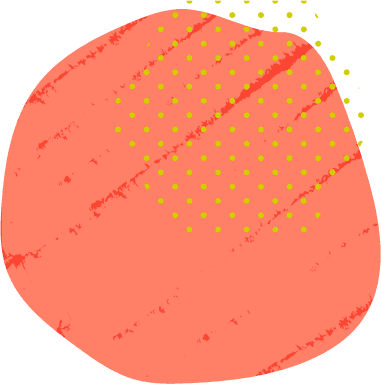Completing one of your internal assessments for QCAA Chemistry and have no idea how to approach the research investigation?
We can help! We’ve come up with this nifty guide which goes through all the different sections of the assessment and examples that you can refer to.
Ready to ace this assignment? Keep scrolling!
What is a Research Investigation?
How do you write up a Research Investigation for Chemistry?
Chemistry Research Investigation Structure
What is a QCAA Chemistry Research Investigation?
A research investigation is a scientific essay in which you evaluate a given claim. This is achieved through researching, analysing and interpreting secondary evidence to form a justified conclusion about the claim.
Your secondary sources must be scientifically credible, and can include research articles, scientific news articles, data compilations, educational resources and more.
How do you write up a Research Investigation for Chemistry?
Ultimately, the findings of your experiment and all the research and analysis you’ve conducted is presented in the form of a 1500-to-2000-word scientific essay.
In order to create a comprehensive Research Investigation, there are 8 steps to follow. These include:
Now that you know the steps to writing a great research investigation, let’s find out how to set it out and what each section needs!
Chemistry Research Investigation Structure
#1: Title
Your title should be clear, comprehensive, and let the reader know what your research investigation is about. It could be in the form of a question or a more general statement.
For example: Chemical Fundamentals — Structure, Properties and Applications of Gadolinium
#2: Claim
State the given/chosen claim here! You may also find that your teacher will give you a general claim with stimulus that you will have to modify or extend to make your own.
#3: Rationale
Your rationale will consist of the general research you conducted on the relevant scientific concepts and theories that relate to the claim. There needs to be a clear connection to the research question.
Don’t forget to explain how your initial research led you to develop the research question!
For example: Until recently, the elements of the Lanthanide series had relatively few applications, as so little was known about these elements and their properties. To understand the current and future applications of Gadolinium, how atomic structure of elements affects their physical and chemical properties will be evaluated…
#4: Research Question
Here is where you state your research question that you have developed to address the claim. Ensure that you have included the variables to be investigated.
You may have to present your research question to your teacher for approval. It’s good to do this regardless of whether it’s compulsory or not, as you don’t want to write your whole report and then be told that you have to change the research question!
For example: How does the atomic structure of Gadolinium affect its properties such as Electronegativity and Covalent Atomic Radius and thus its place in the Lanthanide series?
#5: Background
Here is where you use your research on the concepts and theories surrounding your research question to set the foundations for the rest of your Chemistry Research Investigation.
The quality of your sources and the evidence you draw from them is significant! Ensure that by the end of your background, any and all processes, concepts or theories relating to your research question have been explained.
For example: The nature of a substance consists of its properties; therefore, the periodic nature of the elements is the recurrence of physical and chemical properties in each period and the evident trends, and ultimately, how that affects an element’s place in the periodic table (Helmenstine, 2019).
Up until this point in your QCAA Chemistry Research Investigation, most of the presented information demonstrates your research and planning skills. Let’s have a look at what you need to score top marks in this section of the criteria:
Make note of the fact that you need an informed application of understanding, a considered rationale, effective and efficient investigation, a specific and relevant research question etc. in order to score high marks.
#6: Analysis and Interpretation
This is the largest section of your report and where you present your evidence/data in the form of tables, graphs, charts etc. You then interpret the evidence/data and combine it with your theoretical knowledge from your research to create justified scientific arguments.
Ensure that the evidence/data you choose to incorporate is appropriate, applicable and directly connected to the research question. Identifying meaningful trends, relationships and patterns and using them to justify your scientific arguments is crucial.
You should also identify the limitations of the evidence/data and how those limitations may affect your ability to create your response to the research question. Remember to keep it all relevant to the research question!
For example:
Figure 3: Electronegativity of Lanthanides
When further research was conducted and the electronegativities of the Lanthanide series were also plotted (see Figure 3), it was apparent that the Lanthanides did not follow this trend. This is because both d- and f- electrons shells are much more complex than s- or p- electron shells in the order in which their shells are filled, meaning there is great variation in how the electrons can be arranged (“Electronegativity”, 2019).
#7: Conclusion and Evaluation
This section of your QCAA Chemistry Research Investigation also consists of a number of things — a brief summary of the concepts that were investigated, the relevant findings, and how they apply to your claim should be explained.
Try tying your conclusion and evaluation into a topic you’ve learned from Unit 4 QCAA Chemistry: Structure, Synthesis and Design!
You should include a review of your literature sources and evidence/data (i.e., were there any limitations and how did they affect your ability to create justified scientific arguments). Also include improvements that would address the limitations, as well as possible extensions that would allow further evaluation of the claim.
For example: By evaluating how atomic structure affects the physical and chemical properties of elements, the properties of the Lanthanide Gadolinium were determined… Because of these limitations, it had to be assumed that the trends were accurate and that they applied throughout the Periodic Table. It is suggested that in future, the values of these properties for more of the elements are considered before drawing conclusions.
Because the second part of your Research Investigation is much more comprehensive, there are two criteria relating to it. Let’s check them out:
Again, in order to achieve those top marks, ensure that you’ve included systematic and effective analysis of data, thorough identification of trends, insightful interpretation of research evidence, considered and relevant improvements and extensions etc.
Finally, there’s one more section of criteria to consider, and it applies to the entirety of your report. Although it’s only worth two marks, it’s an easy two marks to get so don’t miss out!
To ensure you get those two marks, remember to:
- Follow the structure and general conventions of a scientific essay (use headings for each section to help with structure)
- Label all evidence/data you present
- Make sure your work is easily understood (stick to simpler vocabulary unless using scientific terminology)
- Stay within the word length
- Provide a comprehensive reference list (make sure it is in the style your school/teacher has requested)
Check out all of our Term 3 Content in one place with the Ultimate Term 3 Guide!
There you have it!
We’ve covered all the different aspects of your Chemistry research investigation so you can feel confident in writing up your assignment! Once you’ve written it, make sure to check that you’ve done everything required of you within the marking guide.
Work out what mark you actually need to achieve to get your goal ATAR with our brand new QCE Cohort Comparison Tool!
Looking for other QCAA Chemistry resources?
Check out our QCAA Chemistry guides below:
- The Definitive Guide to Writing a Student Experiment Report for QCAA Chemistry
- The Ultimate Guide to QCAA Chemistry Unit 3: Equilibrium, Acids and Redox Reactions
Have a go at our collection of practice questions:
- QCAA Unit 3 Chemistry Data Test IA1 Practice Questions
- QCAA Practice Questions for Unit 3 & 4 Chemistry EA
- QCAA Multiple Choice Practice Questions for Unit 3 & 4 Chemistry EA
- Download QCAA Chemistry Practice Exam for External Assessment Revision
Are you looking for some extra guidance with the Research Investigation for QCAA Chemistry?
We have an incredible team of QLD tutors and mentors!
We can help you master the Chemistry syllabus and ace your upcoming Chemistry assessments with personalised lessons conducted one-on-one in your home or online!
We’ve supported over 8,000 students over the last 11 years, and on average our students score mark improvements of over 20%!
To find out more and get started with an inspirational QLD tutor and mentor, get in touch today or give us a ring on 1300 267 888!
Yalindi Binduhewa is an Art of Smart tutor based in Queensland and was part of the very first cohort to go through the ATAR system, so she knows exactly how fun and enjoyable it can be. She is currently studying a Bachelor of Medical Imaging (Honours) at QUT and is loving it. When she’s not doing uni-related stuff or tutoring, she’s hanging out with her friends, rewatching a show for the 100th time, or trying out new crafty projects and discovering that she doesn’t have a talent for everything.









